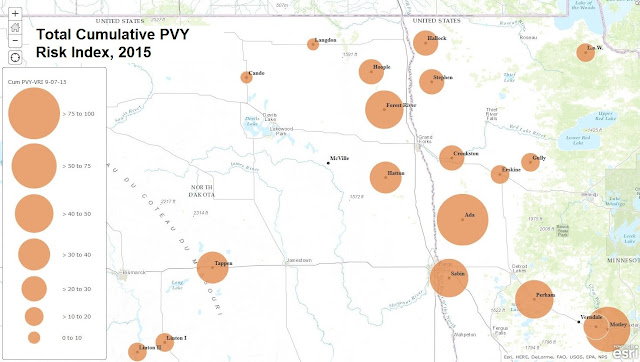Greetings!
More traps are reporting and while aphid vector numbers are slowly rising, although this is partly because of additional trap site reporting. The PVY Risk Index numbers are starting to creep up, check the maps below for your area's risk. .
We recovered Green Peach Aphids from 3 locations (Crookston, Hoople and Lake of the Woods). The rest of the vector species recovered were a bit of a mixed bag and generally low
As always though, keep scouting!
Scouting for aphids in potatoes:
- Select leaves from the lower to mid canopy. Lower, older leaves will have more established colonies and aphids prefer the balance of nutrients found here; aphids are rarely found on leaves in the upper canopy.
- Avoid leaves on the ground or in contact with the soil.
- In seed potatoes there is only a threshold for PLRV (10 aphids/100 leaves), reactive application of insecticides an effective control for PVY.
- The use of feeding suppressing insecticides, such as pymetrozine (Fulfill®) or flonicamid (Beleaf®) and refined crop oils, such as Aphoil and JMS Stylet Oil, at or prior to field colonization by aphids may reduce the transmission of PVY within fields. Some other insecticides, such as clothianidin (Belay®), imidacloprid (Admire Pro® or Provado®), and spirotetramat (Movento®), have also been demonstrated to reduce the transmission of PVY.
- In table stock potatoes, a treatment threshold of 30 aphids /100 leaves should deter yield loss due to aphid feeding.
The PVY Vector Risk Index
Not all species of aphid are equally efficient at transmitting PVY, some are better than others (green peach being the most efficient vector of PVY). So, the total number of aphids in a trap don't necessarily reflect just how much vector pressure there is at that location. The PVY Vector Risk Index compares aphid numbers, incorporating their relative vector efficiency compared to the Queen of PVY vectors (green peach aphid!). Using averaged reference comparisons from the literature, we multiply the number of each aphid species captured by it's efficiency camopred to Green Peach Aphid to more accurately depict risk posed by the species being trapped. We then sum the totals. The PVY-VRI values are presented on the tables below but also on maps comparing current cumulative risk to the total risk from the sample sites of last year (to compare with your local winter grow out results). Click on the map for full sized image.
The map on the left is the current Cumulative PVY-Vector Risk Index for the week of July 11. The Second represents the cumulative seasonal PVY Risk Index
values from 2015.. Our risk index is below last year's but we seem to be later in developing insect populations this year, so it's important to keep scouting!











































